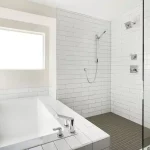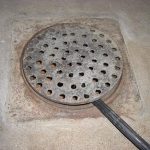Have you ever noticed the drywall next to shower getting wet? This is a common problem that many people experience due to the constant dampness from showering. If left unaddressed, the wet drywall can even damage the structural design inside the wall.
To avoid this issue, it’s important to fix the wet drywall as soon as possible. This involves removing the damaged or wet drywall stud, replacing it with a new one, and applying multiple coats of drywall mud.
In this article, we’ll explore other ways to prevent drywall damage in your bathroom.
What Happens If Water Gets Behind Shower Wall?
If water gets behind your shower wall and remains there for days, it can cause significant damage. The dampness weakens the drywall, causing it to fall from the space, leading to costly repairs. Moreover, if you don’t fix the damp drywall timely, it might damage the home’s structure.
Water can reach the steel structure inside the wall, causing it to rust and corrode. If left unattended, the main structure might become so damaged that it will become unrepairable.
Apart from structural damage, wet drywall in the shower can lead to mold and mildew growth, which can trigger bacterial and viral infestation, making it harmful to the shower space. Maintaining hygiene becomes challenging in such a scenario.
Wet drywall with mold growth also hurts the appearance of the bathroom, which can impact your reputation if guests visit your home. It is essential to fix the issue as soon as possible to avoid further damage. If you cannot fix the issue yourself, it is recommended to call a plumber for assistance.
How To Repair Water-Damaged Shower Walls?
Step 1: Gather the Necessary Tools and Items
To repair the damaged shower wall, you must have the following tools and items:
- Pry bar
- Hammer
- Stud finder and measuring tape
- Level and pencil
- Carpenter’s square and drill
- Trim
- Miter saw
- Finish nail gun and finishing nails
- Drywall
- Drywall screws
- Drywall tape
- Drywall mud and mud pan
- Drywall taping knife and sanding sheet
Once you have gathered all the tools and items, you can proceed to the next step.
Step 2: Remove Studs and Access the Next Drywall
Start by removing the base of the damaged drywall and the nails from the trim. Inspect the trim and see if it is reusable. Find an undamaged stud close to the damaged drywall stud and draw a vertical line along its edge with a pencil or marker. Draw a horizontal line towards the bathtub, above the wet drywall, to create a square that contains the damaged drywall.
Step 3: Remove the Damaged Drywall Completely
Cut along the horizontal and vertical lines with a knife, applying firm pressure to cut through the drywall completely. Tap the damaged drywall firmly to break it into pieces, making it easier to remove. Pry off the sections, remove the nails and screws from the frame, and ensure that the nearest stud has ½ inches edge left next to the framing.
Step 4: Check for Rotted Frame
Inspect the frame for damages and rotting after removing the wet drywall. Replace the damaged studs with 2 by 4 and 2 by 6 studs, and remove adjacent drywalls if necessary.
Step 5: Prepare the New Drywalls
Cut the new drywalls according to their size requirements, trim them smoothly, and connect them closely. Use waterproof drywalls to prevent them from getting wet in the future. Secure the drywall with screws, and maintain an accurate thickness of ½ inches or 5/8 inches.
Step 6: Apply Drywall Mud and Drywall Tape
Apply drywall mud on the screw holes, nuts, and seams to fill any gaps. Place the drywall tape over the mud tightly, squeeze the tape and mud before it sets, and remove the excess mud and tape from the edges with a utility knife. Apply the second coat of mud over the tape, smoothen it with larger knives, and repeat the process two more times.
Step 7: Finish the Repair Work
Install the new stud base and shoe trim for the framing, secure the nails with a finishing nail gun, and fill the slight gap around the drywall and shower space with silicone. Paint the drywall with a similar color in your bathroom, using smoother and smaller brushes and rollers for a better finish.
That’s it! With these steps, you can repair your water-damaged shower walls and make them look as good as new.
How to Prevent Water Damage on Wall Next to Shower?
Use a Dehumidifier:
To prevent water damage on the wall next to your shower, you can use a dehumidifier in your bathroom. Bathrooms are one of the most humid areas in your home, and the additional moisture can slowly cause damage to your drywall. By using a small, portable dehumidifier, you can remove excess humidity and keep your bathroom drier. This will make it less likely for your drywall to become damaged due to high moisture levels.
Use Waterproof Drywall:
Using waterproof drywall is the best way to protect your bathroom and shower walls from water damage. This type of drywall won’t allow water to penetrate, keeping your drywall safe from damage. It will also prolong the lifespan of your bathroom and reduce maintenance costs. You’ll often see waterproof drywall used in shower and bathtub spaces.
Use Shellac or Oil-Based Primer:
If you have conventional drywall without waterproofing capacity in your older home, replacing all of it with waterproof drywall can be costly. Instead, you can apply primer over the old drywall. By using oil or shellac-based primer, you can create an artificial covering that will prevent water from penetrating the drywall. This will keep your drywall safe from damage.
Apply Laminate or Acrylic Walls:
Laminated drywalls are popular these days, and they come in different colors, textures, and patterns. They can help you decorate your bathroom while preventing water damage to your walls. You can also choose acrylic walls, which are available in different textures and patterns. Tiles and gypsum wall panels are also great options for securing your shower and bathtub space from water damage.
By following these preventive measures, you can keep your drywall safe from water damage. Remember, preventing damage is always easier than repairing it. Nonetheless, if you need to fix drywall next to your shower that has been damaged due to water, you can follow our seven steps.




